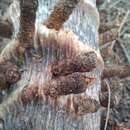fi
nimet breadcrumb-navigoinnissa



Ceratophaga is a genus of moths belonging to the family Tineidae. The name "ceratophaga" is derived from the Greek for "horn eater". Sixteen species are currently recognised, widespread in the Afrotropical realm and Asia. In the Americas one species has been described: Ceratophaga vicinella, which occurs in the southeastern United States. Twelve of the known species occur in Africa, and of those Ceratophaga vastella is perhaps the best-known.
The larvae of most Tineidae (of which clothes moths are the most familiar) have adapted to feeding on non-herbaceous material, but Ceratophaga are remarkable in that they feed, apparently exclusively, on solid keratin from dead vertebrates. For most species this usually means the horns and hooves of ungulates, but the North American Ceratophaga vicinella feeds on the shells of the tortoise Gopherus polyphemus.
 An African species of Horn moth, Ceratophaga vastella, on old Kudu horns. Cases with the exuviae of the emerged moths protruding from the open ends are empty, while intact cases with their ends still closed, contain larvae or pupae of the moths.
An African species of Horn moth, Ceratophaga vastella, on old Kudu horns. Cases with the exuviae of the emerged moths protruding from the open ends are empty, while intact cases with their ends still closed, contain larvae or pupae of the moths. Ceratophaga is a genus of moths belonging to the family Tineidae. The name "ceratophaga" is derived from the Greek for "horn eater". Sixteen species are currently recognised, widespread in the Afrotropical realm and Asia. In the Americas one species has been described: Ceratophaga vicinella, which occurs in the southeastern United States. Twelve of the known species occur in Africa, and of those Ceratophaga vastella is perhaps the best-known.
The larvae of most Tineidae (of which clothes moths are the most familiar) have adapted to feeding on non-herbaceous material, but Ceratophaga are remarkable in that they feed, apparently exclusively, on solid keratin from dead vertebrates. For most species this usually means the horns and hooves of ungulates, but the North American Ceratophaga vicinella feeds on the shells of the tortoise Gopherus polyphemus.
Ceratophaga — род молевидных чешуекрылых из семейства настоящие моли.
Как правило, мелкие бабочки, окрашенные в однотонные тёмные коричневые, серые и т. п. цвета. У большинства видов крылья полностью лишены рисунка, а у некоторых видов он слабо выражен. Крылья ланцетовидной формы, задние — с выраженной бахромкой. Челюстные щупики тонкие, состоят из пяти члеников. Как и другие представители семейства настоящие моли, ведут скрытный образ жизни, обычно активны в вечернее время. Тело гусениц более или менее цилиндрическое, покрыто мягкой кутикулой.
Род включает 16 видов, из которых 12 обитает в Африке, ещё три встречается в Азии, и один — Ceratophaga vicinella, как исключение из рода, обитает в Северной Америке на юго-востоке США[1].
Гусеницы африканских видов, например Ceratophaga vastella, обнаружены в рогах как живых[2], так и мёртвых антилоп и буйволов, где они питаются кератином[3][4]. А гусеницы вида Ceratophaga vicinella, обитающего в южной Флориде, питаются панцирями мёртвых черепах гофер-полифем (Gopherus polyemus)[1]. Каждая гусеница сооружает неразветвленный ход-трубку из шёлка, которые простирается от пластин панциря черепахи в подлежащий песчаный грунт на глубину 3—10 см. При разложении туши черепахи, отдельные щитки часто отслаиваются от кости панциря, личинки также питаются ими[1]. Окукливание происходит в почве[1].
В состав рода включают следующие виды:
Ceratophaga — род молевидных чешуекрылых из семейства настоящие моли.